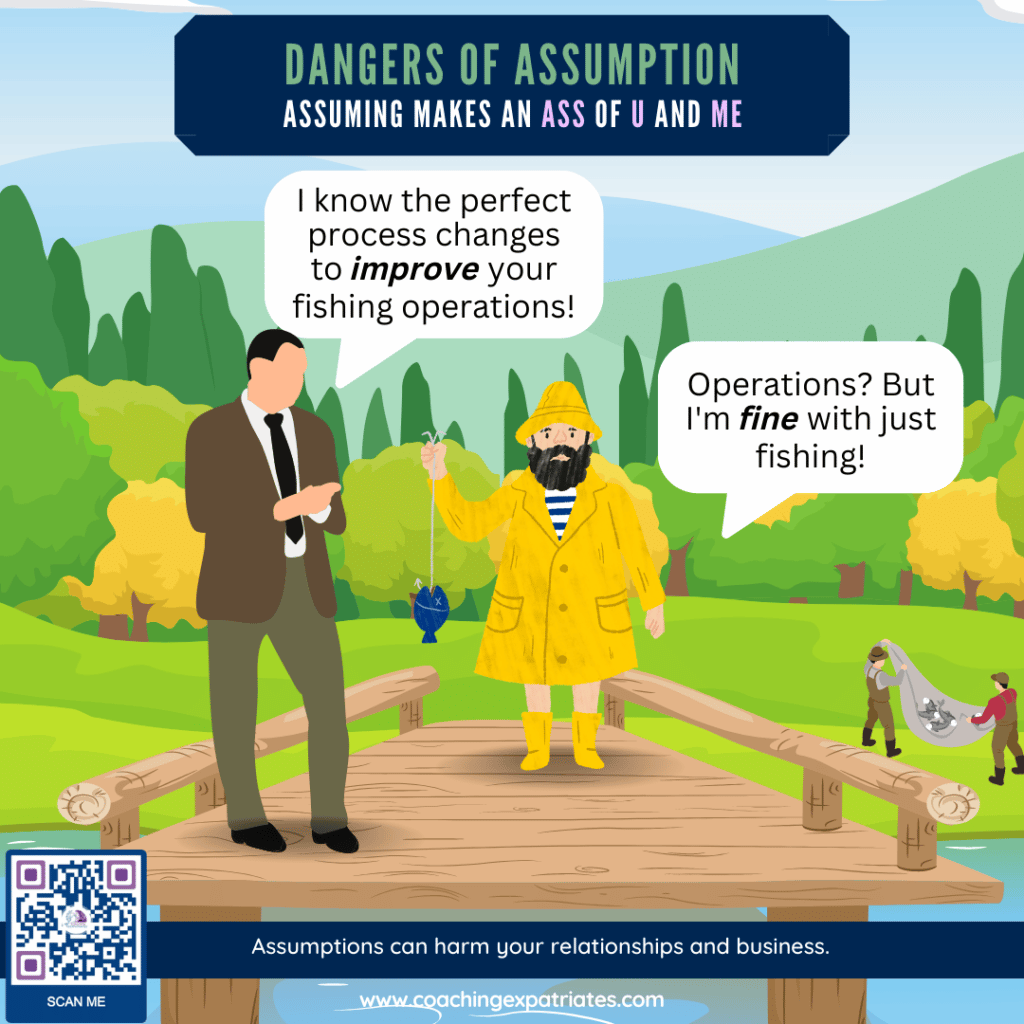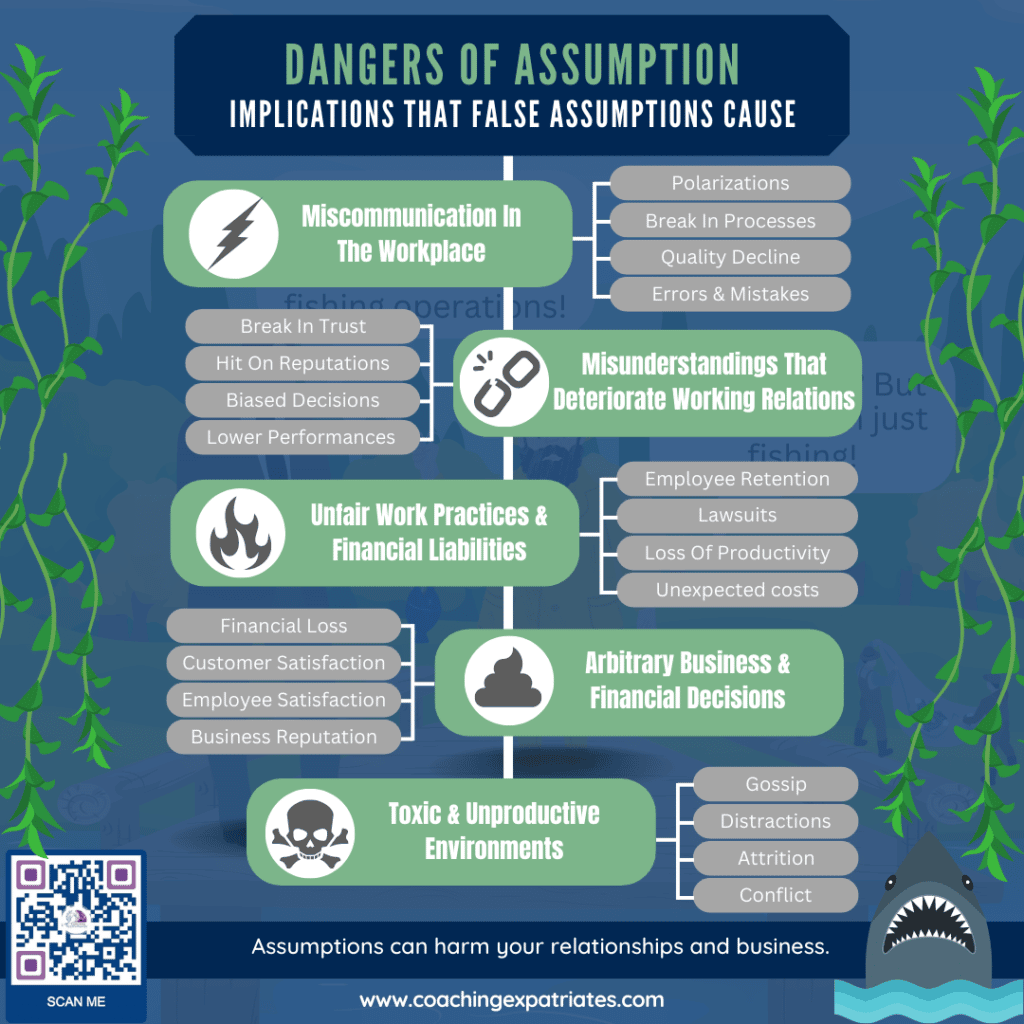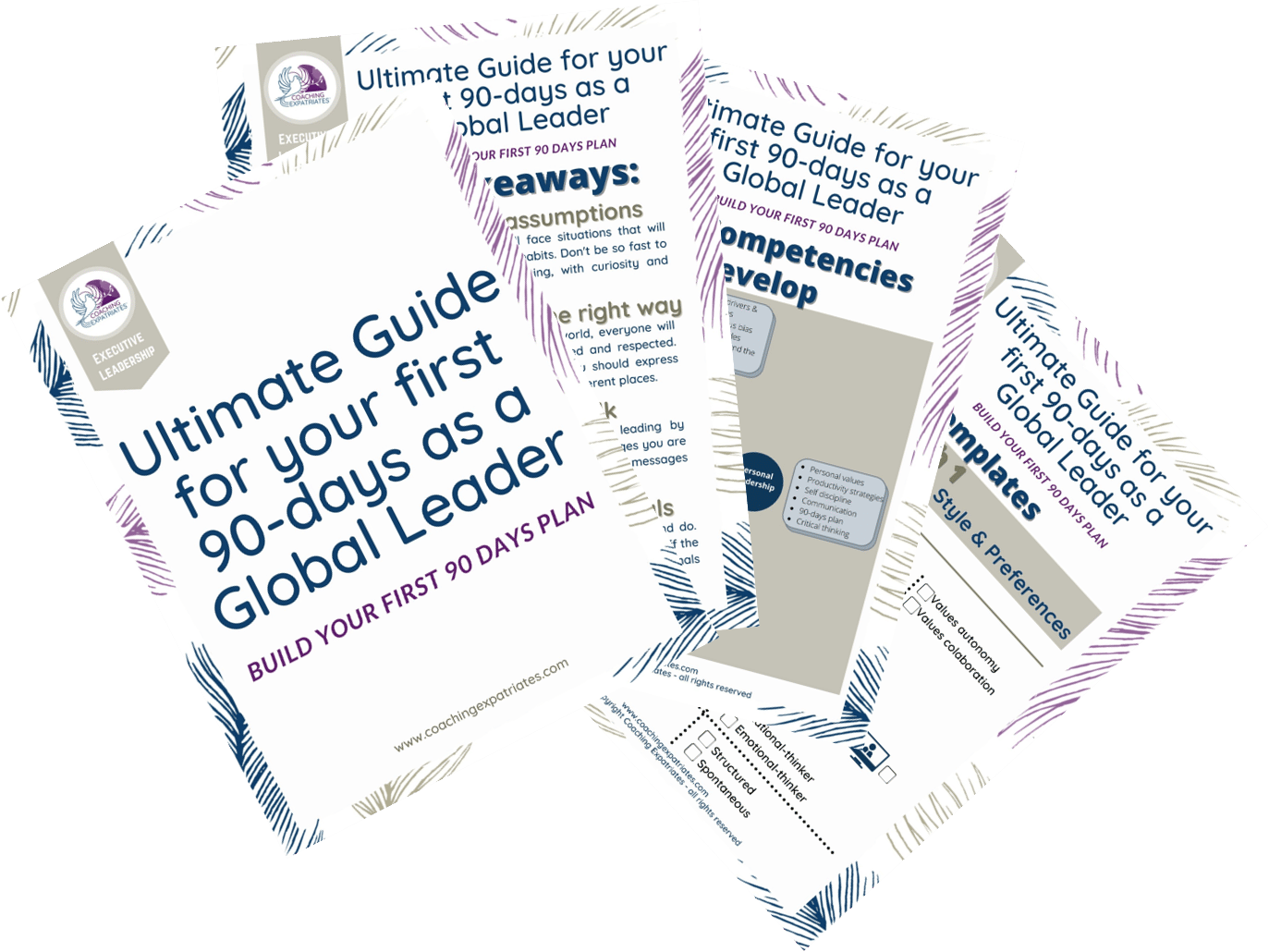Assuming things is what human beings have been doing for millions of years, which kept us alive on many occasions. So why exactly am I writing an article about the dangers of assumptions? Because, like carbs, our realities now changed and cannot accommodate assumptions as well as before. In other words, assumptions today can harm you, your relations, and your career. I will teach you today when they are helpful and when they are harmful and how to use this knowledge to your favor. After all, avoiding assumptions is part of a success-oriented mindset.
When Are Assumptions Helpful And When Are Assumptions Harmful?
If you’ve been following me, you know that I advocate that assumptions are dangerous in global leadership and that you should avoid them as a global leader.
In many of my coaching sessions, the following phrase commonly appears: “yeah, I thought this way because I assumed…”
Making assumptions is something pretty natural. In fact, years of evolution molded us into assumption machines, and that’s how we survived! So it’s absolutely normal that now all of us are having a tough time avoiding the very thing that kept humans alive for so long.
In this day and age, though, learning how to best use assumptions is critical.
So how can we discern if an assumption is helpful or harmful? When assumptions are part of a validation process, they are helpful and can be even powerful. If you are in a safe, known, and civilized environment, any other types of impromptu assumptions may be harmful.
Before we talk about the dangers of assumptions per se, let’s first define what an assumption really is.
What Are Assumptions?
Assumptions are suppositions we make based on previous experiences and connections. They are thoughts or ideas that are accepted as true or as certain to be or happen, but that we don’t have proof of.
There is the curious story of the executive who meets the fisherman. A lot of people know this tale. The executive finds many “flaws” in the fisherman’s operation and suggested things for him to expand his “operations” and make more money. The executive makes an underlying assumption. What’s the assumption? It’s the assumption that the fisherman would want to change the way he does things if that meant making more money. And there is also the premise that the fisherman would want more money in the first place.
Assumptions are things that we take as obvious, although they might not be true. And there lie the dangers of assumptions.


Dangers Of Assumptions: What Can False Assumptions Lead To?
Before we move on, to improve your awareness about the dangers of assumptions, let’s view key things that happen when we make false assumptions in global corporations and businesses:
Miscommunication In The Workplace
Assumptions can play a big role in work miscommunication in global settings and remote environments. It affects the productivity and profitability of a company, created by polarizations, breaks in processes, quality decline, and errors and mistakes.
Misunderstandings That Deteriorate Working Relations
Whenever we have a misunderstanding due to false assumptions, this will erode the trust people have in us. This happens not only with the people involved in the misunderstanding but also those who know about it. And that’s because wrong assumptions hit reputation when the assumption is finally illuminated. The fuss can, of course, impact performance.
Unfair Work Practices And Financial Liabilities
It’s easy to be unfair when we are clouded about the correct facts and things. Wrong assumptions may lead to unfair practices that might hurt us as an executive and our company’s reputation. It can also lead to lawsuits, lower employee retention, loss of productivity, and unexpected costs to put out a fire.
Arbitrary Business & Financial Decisions
Whenever we take action based on wrong assumptions, we are actually making an arbitrary decision. If you are going towards north, when you should be heading south, any path you continue ahead in the wrong direction will lead you to arbitrary decisions. It can lead to financial loss, customer and employee dissatisfaction, and a hit on the business reputation.
Toxic & Unproductive Environments
False assumptions can easily create toxic environments and provide leeway to gossip, distractions, attrition, and conflicts.

Dangers Of Assumptions: Impromptu Versus Process-Based
Assumptions are things you hold to be true without having proof of them yet. You can have 2 kinds of assumptions.
Impromptu Assumptions:
Impromptu assumptions are thoughts and ideas you take as true on an impromptu basis or that are circumstantial. These are assumptions we make on the spot, depending on what’s going on around us. Impromptu assumptions are what humans have used to assess conditions around them to survive.
Impromptu Assumption Example:
One example of an impromptu assumption in today’s day & age is when you bump into that new employee in the corridor, and something makes you immediately assume that they are arrogant. When they come to talk with you, you are cold and braggy. After you go separate ways, you face-palm yourself and ask, “what got into me?”
Most of the time, impromptu assumptions are triggered by biases. Biases can be either conscious or unconscious. In this example, a bias probably triggered the assumption that led you to perceive arrogance in the other person.
Maybe in the past, you encountered arrogant people who were all blond and were always wearing cowboy boots, and this person was also a blond wearing cowboy motives, so this setup triggered your bias.
It could be anything, really. Every one of us has biases, which are created depending on our previous experiences in life. That’s why most of our impromptu assumptions are actually triggered by unconscious biases: those biases that we might not even be aware of. If you want to learn more about your biases, I suggest you start by checking out Project Implicit and taking one of its tests.
Danger of Assumption: Impromptu
The danger of this kind of assumption is obvious: you can become a jerk. Or worse, you can make wrong decisions that will impact your life, career, and reputation. And that’s because these assumptions create misunderstandings, break trust-building efforts, and provide fertile ground for negative emotions.
Process-Based Assumptions:
Process-based assumptions exist as part of a process. It’s usually used in research, statistical analysis, six sigma designs, and many other processes that usually focus on creating a solution. This second type of assumption will be explored later on.
Process-Based Assumption Example:
One example of process-based assumption could be when you buy a new production machine whose supplier told you it could produce 1,000 products before the first defect. To test this assumption (or claim), you create a quality checkup process for batches of a thousand products to validate the assumption. You might change your production and quality checkup process or not, depending on if this assumption is validated or debunked.
Danger of Assumption: Process-based
The danger of this type of assumption is assuming they are true without testing just because someone else created a claim for you. In other words, believing in third parties’ premises: if the supplier said so, it must be true. This type of assumption must always be validated, like any other assumption!
If you decide to accept a claim blindly, make sure you know exactly what the consequences are if you are wrong, what it will cost you, and what Plan B you have as countermeasures.
For now, I want you to know the difference so that you can learn that the dangers of assumptions come mostly from those that are impromptu because they make us take wrong stances or make decisions that we’ll regret.
How To Curb Impromptu Assumptions
The interesting thing about impromptu assumptions is that you can’t realize you are making them until you find out they are wrong.
Recently, I called a Vet Clinic to set an appointment for my puppy. The receptionist said she had a spot the next day at 7. I assumed it was a 7 a.m. appointment, since everybody wakes up really early in the US. That’s an impromptu assumption. I told the receptionist I could not make such an early appointment and asked if she had something for later. She then realized she had also made an assumption. She assumed that I knew the clinic was open from 8 a.m. to 8 p.m., so obviously, the 7 was a p.m. appointment.
This is a trivial misunderstanding that was quickly reverted, but in global leadership, trivial things can escalate into bigger things, and that’s why we should avoid assumptions.
The best way to curb assumptions is by using 2 communication techniques: Clarification and Checking understanding.
Clarifications can be when you clarify what you just said as the sender of a message or when you ask for clarification as the receiver of a message.
In my example above, I should have asked: “can you clarify if this is an AM or PM appointment?”
As I said, many impromptu assumptions are not even identified as such. At the time, I did not notice that she did not even say AM or PM. In my head, I immediately formed an assumption it was in the morning. I “heard” AM without really hearing it.

In global leadership meetings, misunderstandings are frequent exactly because of these kinds of issues. We unconsciously suppress from our sentences what we think is obvious.
To counter this, you can always include an “SOP,” the acronym for a standard operating procedure, for clarifying things for meetings, such as:
- What is the time zone of this meeting?
- Is this a PM or AM appointment?
- What’s the location of the meeting?
- Do you expect a virtual or in-person meeting?
- Is there something you are expecting me to bring?
- Do you expect me to invite someone else?
Whenever I am setting an appointment, I always “confirm” it by reading back what we just agreed with the other person, and also asking the questions above. This confirmation is the use of the second technique, the “checking understanding.” For this vet example, I would not ask the time zone and location questions since I was going for an in-loco office visit where I’ve been before.
Meetings are just an example. You can create your own SOP to clarify and check your understanding of specific work-related things. For example, I have a question checklist to make sure I clarify things when I talk to my prospects for the first time. With time and experience, you will learn which leading causes of misunderstandings and miscommunication at your work come from assumptions. And you will learn to adopt these 2 techniques to your circumstances precisely to avoid the dangers of assumptions.
Using Assumptions In A Validation Process
Many regular problem-solving processes today use this sort of validation outline that I will teach you below. When your doctors need to nail the correct diagnosis, the statistician needs to understand their data, and engineers need to fix a problem, they all use a validation process before taking action.
Here is how it usually goes.
Step 1. Define The Problem
That’s the easy part. Usually, you identify quickly when you have a problem because many stakeholders come to you with a complaint. For example, you could be a global manager managing operations in many different countries, and country A shows a vertiginous drop in sales this year. Your problem is a drastic drop in Sales in Country A for the current year, which likely will make them fail their budget, which creates the problem of having to cover for it elsewhere. In this example, you have a clear identified problem.
Step 2. Create A Hypothesis
Defining the problem is good, but you can’t find a solution for a problem if you don’t know what’s causing it in the first place. You make assumptions about the problem’s existence so that you can explore potential avenues of the root causes.
In my pet’s case, when we went to the clinic, the doctor suspected he had a liver issue. Her assumption, or hypothesis, was that something was wrong with the liver. She could treat him without validating this assumption, but if she were wrong, the treatment would fail, and we would lose precious time.
In essence, you validate assumptions to quickly find out the root cause of your problems and take action on the right things.
Step 3. Test or Validate Assumptions
While you have untested or invalidated assumptions, they are just that: assumptions. You need to test them to see their validity.
In my pet’s case, my pet’s doctor did some exams to validate her assumptions about his liver.
When validating assumptions, 2 things can happen. You can either find out that they are right and go on to the next step of the process below, or you find out that they are wrong and go back to making a new assumption to be validated. You will create and validate assumptions until you find the right one. That’s how it works in this step.
In the budget case above, the executive in question, who was literate in finance essentials, tested various assumptions until they found the one that was right and out of their control: they found out that the country had an unfavorable exchange rate that was impacting the translated numbers. Even though, in local currency, they were selling pretty much the same amount as the previous year, due to currency changes year-over-year, when converted to the company’s official currency, the amount was way lower now than the previous year. In this example, the executive tested assumptions until he found out which one was right.
Step 4. Pinpoint Root Cause
After you (in)validate assumptions over and over, at some point, you will find out the assumption that was right. You are aiming to find out the root cause of the problem after the validated assumption comes out, in essence. This step is just an acknowledgment of the root cause of the problem.
Step 5. Create A Plan
After you find out the root cause of a problem, you probably want to solve it. Now that you have a clear picture of what the problem is, you can create a plan based on solid facts and ideas to solve your problem. You can use many planning strategies in this step, and it’s a matter of experience, preference, and budget.
Step 6. Take Action
Plans are great, but they mean nothing if you don’t put them into action. Once you know the root cause of a problem and have a plan in place, it’s just a matter of rolling up the sleeves and getting it done. Because you avoided the dangers of assumptions by following this step-by-step process, your chances of success are far greater.
Step 7. Adjourn
Most validation processes tend to forget this important step. Adjourning is the act of taking the time to review lessons learned. It’s a purposeful break to review everything that happened and how things went so that you can learn from the process, take notes to replicate the positive things, and avoid the bad things the next time.
Final Thoughts On The Dangers Of Assumptions
To fully avoid the dangers of assumptions, the critical aspect of this process is the step of validation, step 3. By validating an assumption, you are redefining it as either a correct fact or a wrong assumption. The exercise of validation is vital so that you can create a plan based on something solid that you know to be true.
Imagine in the Vet Clinic story, if I took the 7 appointment spot without clarifying if it was AM or PM, and then showed up at 7 a.m. at a closed clinic with my panting pet? Imagine my frustration. If we are ever taking action over assumptions, they better be correct, right?
Global Leadership interactions can be taxing, and misunderstandings can make you feel less confident and engaged at work. If you are an international leader dealing with uncertainty and struggling with navigating your corporate environment, hire me as your executive and leadership coach. We can map out what’s going on and devise strategies to help you improve your communication and executive presence. We will work as accountability partners during the execution of your plan to quickly help you lead confidently. Book a Free Strategy Session with me.
If you are interested in developing your global leadership skills further, check out our online Global Executive Leadership Program. We go over all 4 success pillars of Global Leadership during 9 online modules.
If you enjoyed this post, consider subscribing to our newsletter using the form below. We focus on providing good content to global leaders and executives who want to make impactful business decisions and be more inclusive and influential. We know your inbox is sacred, so we email just once per week, and we never sell your information. Trust is the basis of Global Leadership, and we fully honor it.







